Detection of Multi-Layered Bond Delamination Defects Based on Full Waveform Inversion
Abstract
1. Introduction
2. Method
2.1. Full Waveform Inversion
2.1.1. Forward Simulation
2.1.2. Inversion Theory
2.2. Regularization Methods
2.3. Error Analysis
3. Numerical Test
3.1. The Effect of the Degree of Phase Velocity Variation on Detection Accuracy
3.2. The Effect of Transducer Installation Position on Detection Accuracy
4. Experimental Test
4.1. Pulse-Echo Method
4.2. FWI Method
5. Conclusions
Author Contributions
Funding
Institutional Review Board Statement
Informed Consent Statement
Data Availability Statement
Conflicts of Interest
References
- Guyott, C.C.H.; Cawley, P.; Adams, R.D. The non-destructive testing of adhesively bonded structure: A review. J. Adhes. 1986, 20, 129–159. [Google Scholar]
- Cawley, P. Ultrasonic measurements for the quantitative NDE of adhesive joints-potential and challenges. In Proceedings of the IEEE 1992 Ultrasonics Symposium, Tucson, AZ, USA, 20–23 October 1992; IEEE: New York, NY, USA, 1992; pp. 767–772. [Google Scholar]
- Honarvar, F.; Varvani-Farahani, A. A review of ultrasonic testing applications in additive manufacturing: Defect evaluation, material characterization, and process control. Ultrasonics 2020, 108, 106227. [Google Scholar] [PubMed]
- Fang, Y.; Lin, L.; Feng, H.; Lu, Z.; Emms, G.W. Review of the use of air-coupled ultrasonic technologies for nondestructive testing of wood and wood products. Comput. Electron. Agric. 2017, 137, 79–87. [Google Scholar]
- Szilard, J. Ultrasonic Testing: Non-Conventional Testing Techniques; John Wiley & Sons, Inc.: New York, NY, USA, 1982; Volume 640, p. 1982. [Google Scholar]
- Zhao, X.; Royer, R.L.; Owens, S.E.; Rose, J.L. Ultrasonic Lamb wave tomography in structural health monitoring. Smart Mater. Struct. 2011, 20, 105002. [Google Scholar]
- Liu, Z.; Zhong, X.; Xie, M.; Liu, X.; He, C.; Wu, B. Damage imaging in composite plate by using double-turn coil omnidirectional shear-horizontal wave magnetostrictive patch transducer array. Adv. Compos. Mater. 2017, 26 (Suppl. S1), 67–78. [Google Scholar]
- He, J.; Yuan, F.G. Damage identification for composite structures using a cross-correlation reverse-time migration technique. Struct. Health Monit. 2015, 14, 558–570. [Google Scholar] [CrossRef]
- Qiu, L.; Liu, B.; Yuan, S.; Su, Z.; Ren, Y. A scanning spatial-wavenumber filter and PZT 2-D cruciform array based on-line damage imaging method of composite structure. Sens. Actuators A Phys. 2016, 248, 62–72. [Google Scholar]
- Zhao, G.; Zhang, D.; Zhang, L.; Wang, B. Detection of defects in reinforced concrete structures using ultrasonic nondestructive evaluation with piezoceramic transducers and the time reversal method. Sensors 2018, 18, 4176. [Google Scholar] [CrossRef]
- Wang, J.; Shen, Y. An enhanced Lamb wave virtual time reversal technique for damage detection with transducer transfer function compensation. Smart Mater. Struct. 2019, 28, 085017. [Google Scholar]
- Tong, J.; Lin, M.; Wang, X.; Li, J.; Ren, J.; Liang, L.; Liu, Y. Deep learning inversion with supervision: A rapid and cascaded imaging technique. Ultrasonics 2022, 122, 106686. [Google Scholar] [CrossRef]
- Qian, Z.; Wang, B.; Zhang, Y.; Wang, S.; Li, P.; Qian, Z.; Kuznetsova, I. Guided Wave Tomography of Surface Defects Based on the Method of Moments. Adv. Theory Simul. 2023, 6, 2300121. [Google Scholar] [CrossRef]
- McKeon, J.C.P.; Hinders, M.K. Parallel projection and crosshole Lamb wave contact scanning tomography. J. Acoust. Soc. Am. 1999, 106, 2568–2577. [Google Scholar] [CrossRef]
- Malyarenko, E.V.; Hinders, M.K. Fan beam and double crosshole Lamb wave tomography for mapping flaws in aging aircraft structures. J. Acoust. Soc. Am. 2000, 108, 1631–1639. [Google Scholar] [CrossRef] [PubMed]
- Belanger, P.; Cawley, P.; Simonetti, F. Guided wave diffraction tomography within the born approximation. IEEE Trans. Ultrason. Ferroelectr. Freq. Control 2010, 57, 1405–1418. [Google Scholar] [CrossRef] [PubMed]
- Huthwaite, P. Evaluation of inversion approaches for guided wave thickness mapping. Proc. R. Soc. A Math. Phys. Eng. Sci. 2014, 470, 20140063. [Google Scholar] [CrossRef]
- Huthwaite, P.; Simonetti, F. High-resolution imaging without iteration: A fast and robust method for breast ultrasound tomography. J. Acoust. Soc. Am. 2011, 130, 1721–1734. [Google Scholar] [CrossRef] [PubMed]
- Virieux, J.; Operto, S. An overview of full-waveform inversion in exploration geophysics. Geophysics 2009, 74, WCC1–WCC26. [Google Scholar] [CrossRef]
- Bernard, S.; Monteiller, V.; Komatitsch, D.; Lasaygues, P.L. Ultrasonic computed tomography based on full-waveform inversion for bone quantitative imaging. Phys. Med. Biol. 2017, 62, 7011. [Google Scholar] [CrossRef]
- Pérez-Liva, M.; Herraiz, J.L.; Udías, J.M.; Miller, E.; Cox, B.T.; Treeby, B.E. Time domain reconstruction of sound speed and attenuation in ultrasound computed tomography using full wave inversion. J. Acoust. Soc. Am. 2017, 141, 1595–1604. [Google Scholar] [CrossRef]
- Nguyen, T.D.; Tran, K.T.; Gucunski, N. Detection of bridge-deck delamination using full ultrasonic waveform tomography. J. Infrastruct. Syst. 2017, 23, 04016027. [Google Scholar] [CrossRef]
- He, J.; Rao, J.; Fleming, J.D.; Gharti, H.N.; Nguyen, L.T.; Morrison, G. Numerical ultrasonic full waveform inversion (FWI) for complex structures in coupled 2D solid/fluid media. Smart Mater. Struct. 2021, 30, 085044. [Google Scholar] [CrossRef]
- Rao, J.; Sing, S.L.; Lim, J.C.W.; Yeong, W.Y.; Yang, J.; Fan, Z.; Hazell, P. Detection and characterisation of defects in directed energy deposited multi-material components using full waveform inversion and reverse time migration. Virtual Phys. Prototyp. 2022, 17, 1047–1057. [Google Scholar] [CrossRef]
- Rao, J.; Ratassepp, M.; Fan, Z. Guided wave tomography based on full waveform inversion. IEEE Trans. Ultrason. Ferroelectr. Freq. Control 2016, 63, 737–745. [Google Scholar] [CrossRef] [PubMed]
- Rao, J.; Ratassepp, M.; Fan, Z. Investigation of the reconstruction accuracy of guided wave tomography using full waveform inversion. J. Sound Vib. 2017, 400, 317–328. [Google Scholar] [CrossRef]
- Rao, J.; Ratassepp, M.; Fan, Z. Quantification of thickness loss in a liquid-loaded plate using ultrasonic guided wave tomography. Smart Mater. Struct. 2017, 26, 125017. [Google Scholar] [CrossRef]
- Ratassepp, M.; Rao, J.; Yu, X.; Fan, Z. Modeling the Effect of Anisotropy in Ultrasonic-Guided Wave Tomography. IEEE Trans. Ultrason. Ferroelectr. Freq. Control 2021, 69, 330–339. [Google Scholar] [CrossRef] [PubMed]
- Hustedt, B.; Operto, S.; Virieux, J. Mixed-grid and staggered-grid finite-difference methods for frequency-domain acoustic wave modelling. Geophys. J. Int. 2004, 157, 1269–1296. [Google Scholar] [CrossRef]
- Zhang, Y.; Sun, Q. Symbol LU decomposition method of large scale sparse linear equations. Comput. Eng. Appl. 2007, 43, 29–30. [Google Scholar]
- Plessix, R. A review of the adjoint-state method for computing the gradient of a functional with geophysical applications. Geophys. J. Int. 2006, 167, 495–503. [Google Scholar] [CrossRef]
- Guitton, A.; Symes, W.W. Robust inversion of seismic data using the Huber norm. Geophysics 2003, 68, 1310–1319. [Google Scholar] [CrossRef]
- Druet, T.; Tastet, J.L.; Chapuis, B.; Moulin, E. Autocalibration method for guided wave tomography with undersampled data. Wave Motion 2019, 89, 265–283. [Google Scholar] [CrossRef]
- Zheng, J. Research on Baseline Free Lamb Wave Damage Detection Method Based on Time Reversal. Master’s Thesis, Nanjing University of Aeronautics and Astronautics, Nanjing, China, 2011. [Google Scholar]
- Zhang, Y.Y.; Zhang, P.Y.; Yang, R.R.; Wen, Y.T.; Li, Z.L. Recognition Method of Bonding Defects between Component Layers Based on Ultrasonic Testing. Meas. Control Technol. 2021, 40, 57–62. [Google Scholar]
- Xu, W.; Yuan, M.; Xuan, W.; Ji, X.; Chen, Y. Quantitative Inspection of Complex-Shaped Parts Based on Ice-Coupled Ultrasonic Full Waveform Inversion Technology. Appl. Sci. 2021, 11, 4433. [Google Scholar] [CrossRef]
- Li, J.; Rose, J.L. Natural beam focusing of non-axisymmetric guided waves in large-diameter pipes. Ultrasonics 2006, 44, 35–45. [Google Scholar] [CrossRef] [PubMed]
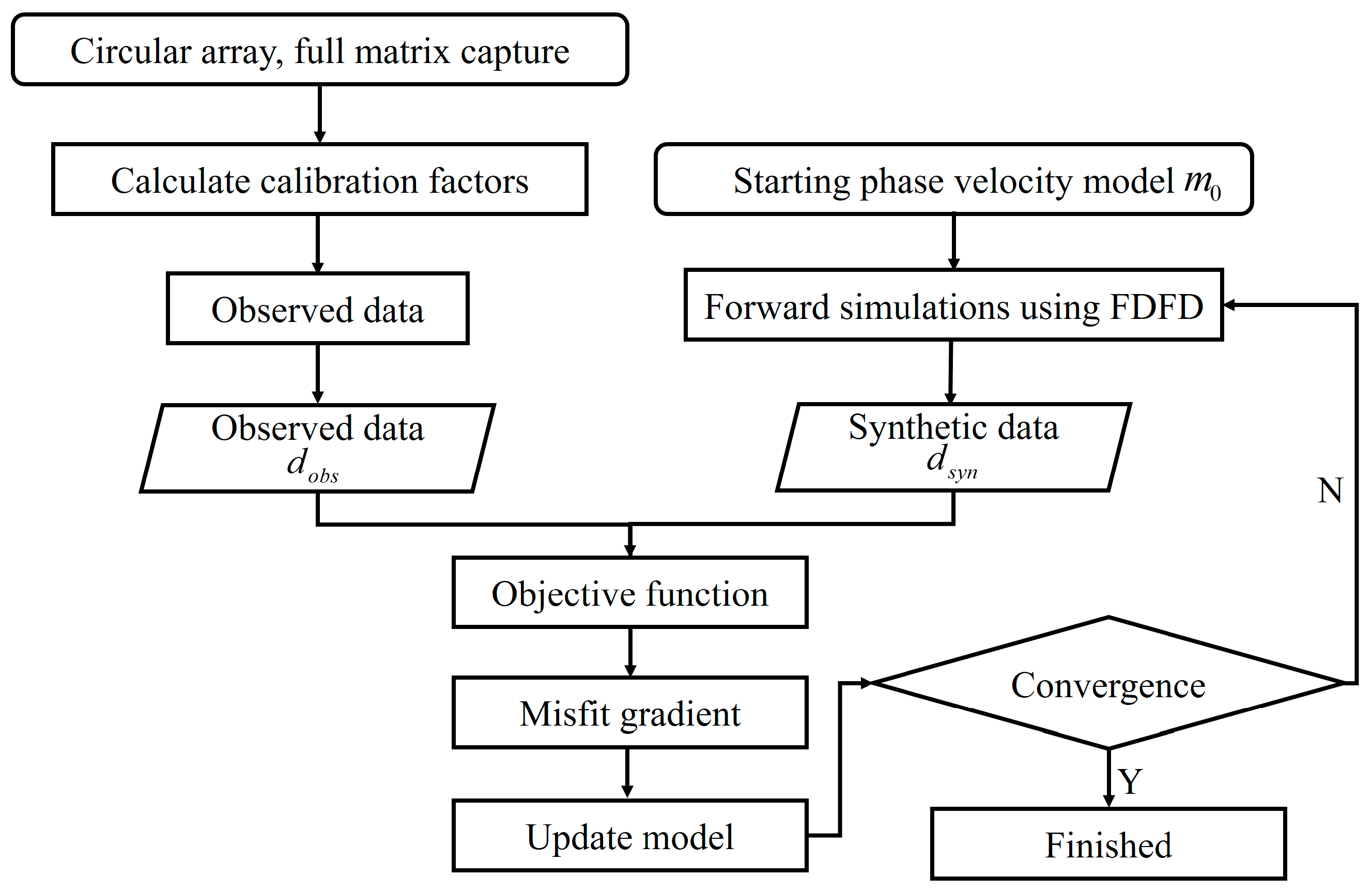

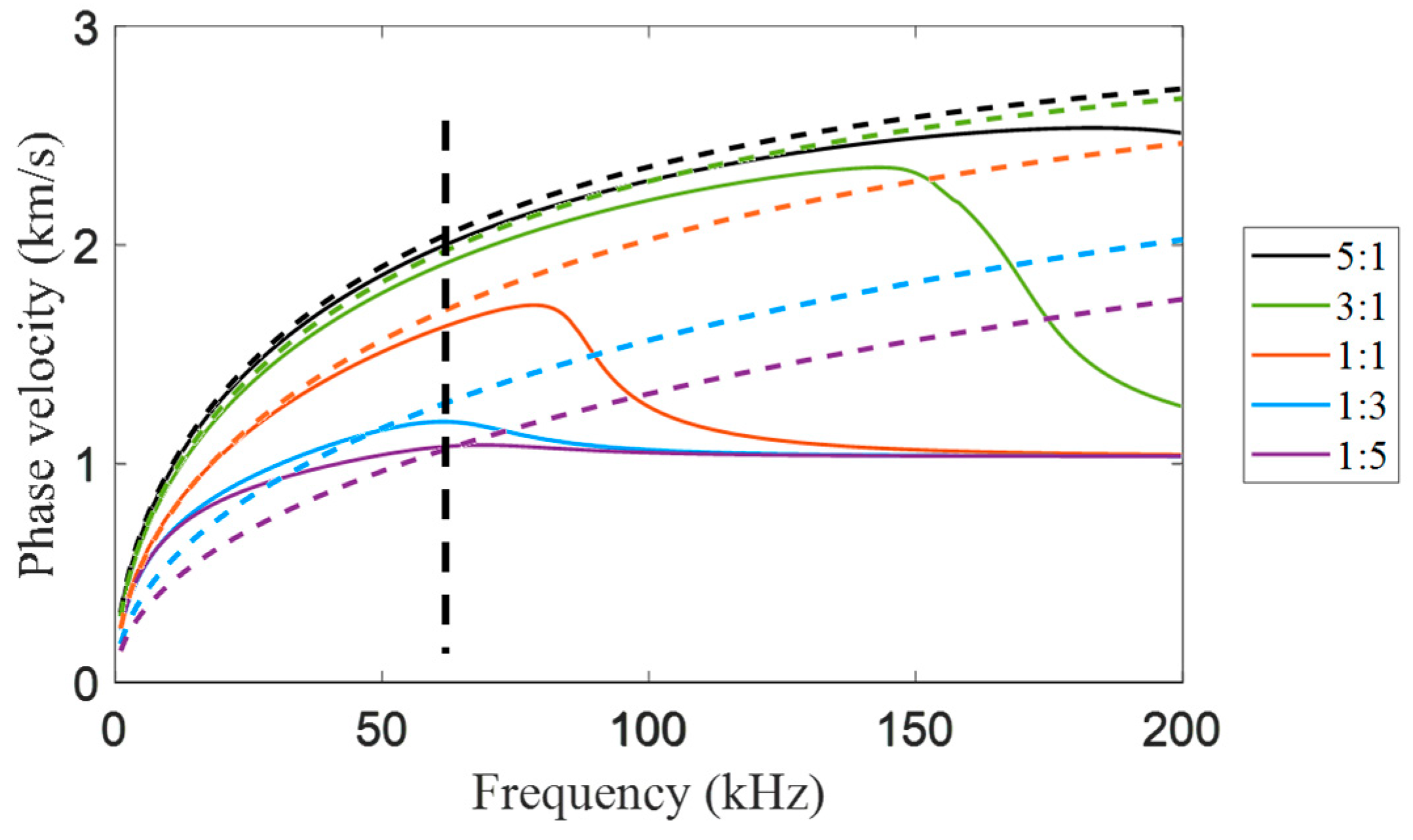




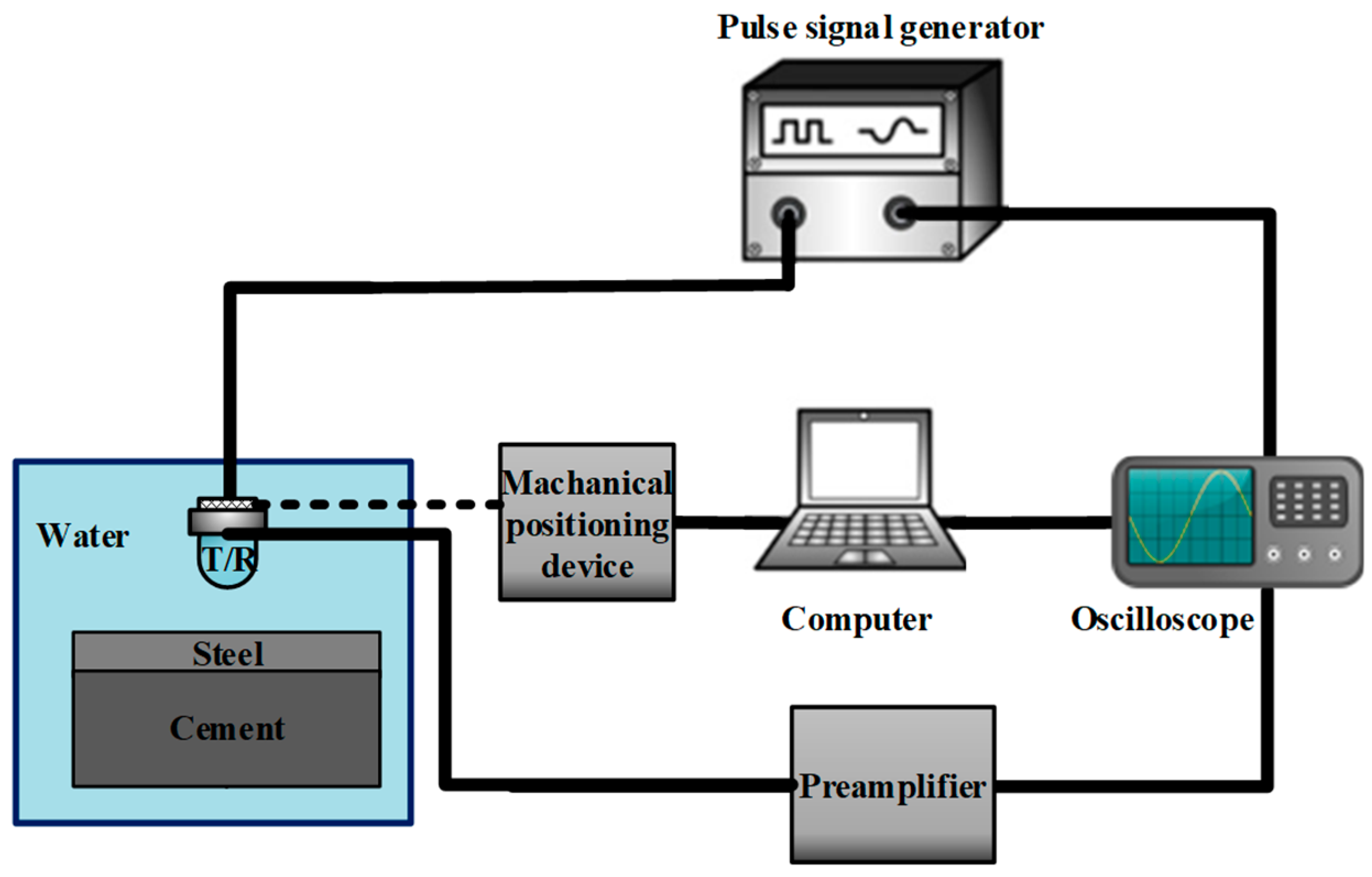
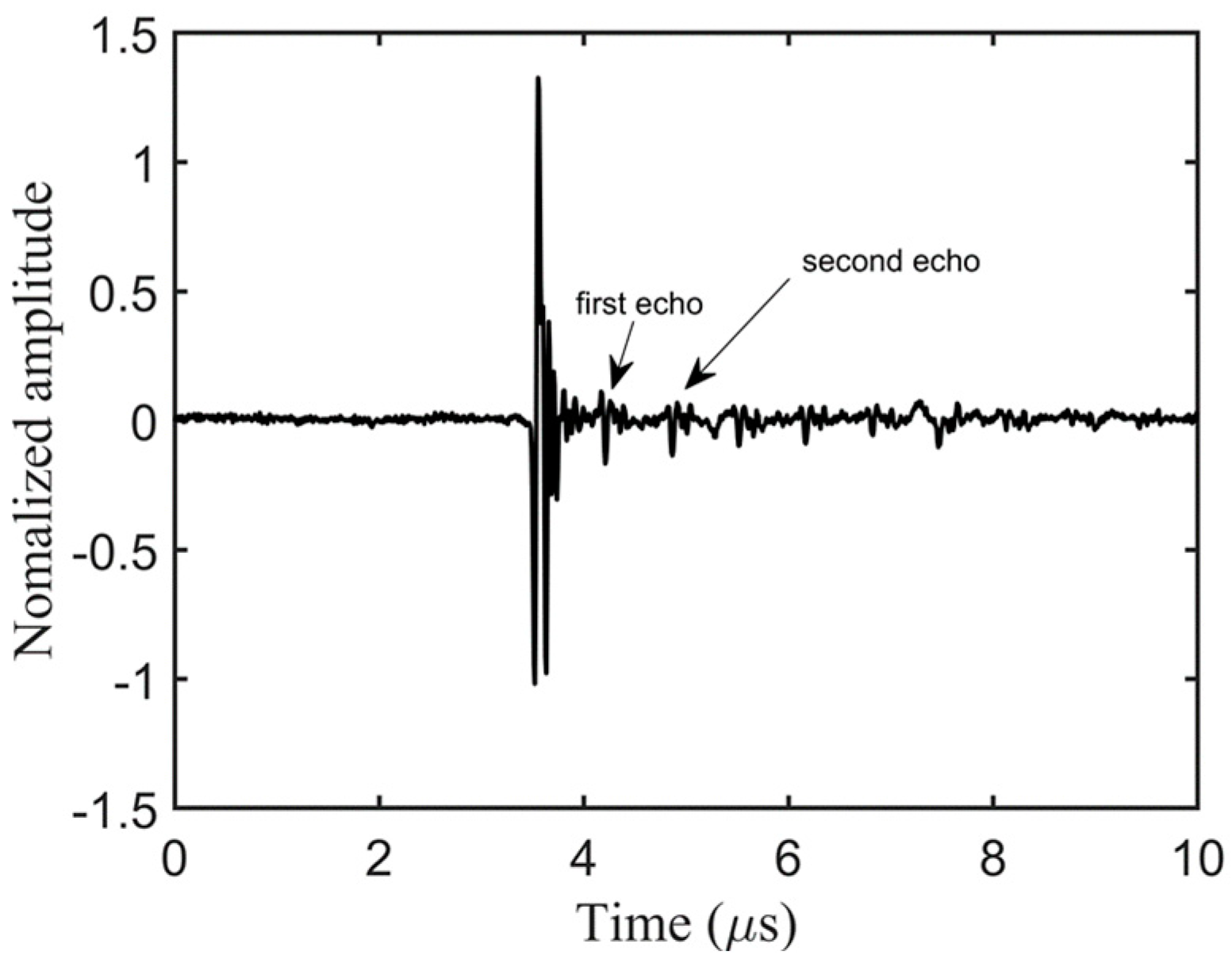

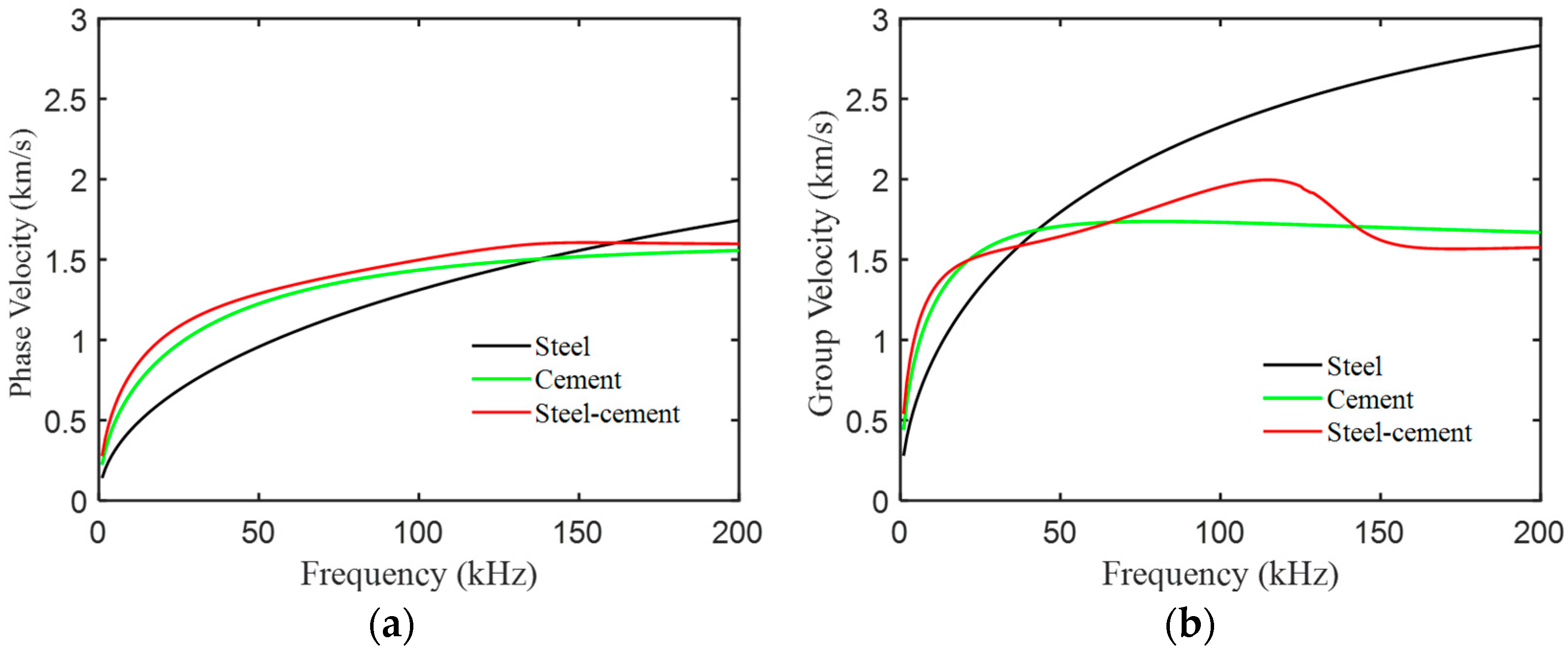
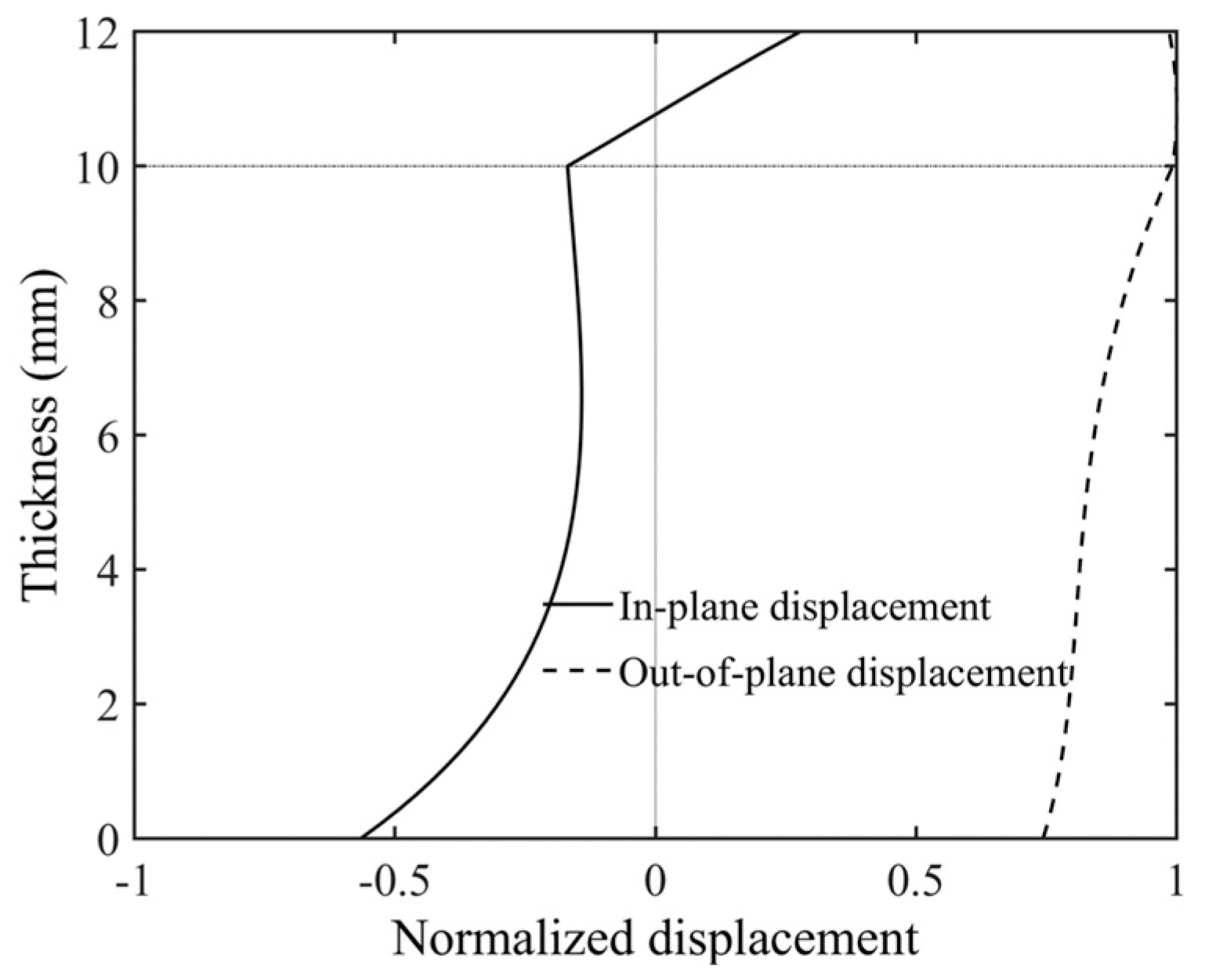



| Material | ρ (kg/m3) | CT (m/s) | CS (m/s) |
|---|---|---|---|
| Aluminum | 2700 | 6364 | 3170 |
| Epoxy adhesive | 1170 | 2610 | 1102 |
| Thickness Ratio | RMSE (m/s) |
|---|---|
| 5:1 | 1.80 |
| 1:3 | 2.97 |
| Transducer Installation Positions | RMSE (m/s) |
|---|---|
| Aluminum plate surface | 1.92 |
| Epoxy adhesive surface | 2.21 |
| Material | ρ (kg/m3) | CT (m/s) | CS (m/s) |
|---|---|---|---|
| Steel | 7850 | 5890 | 3240 |
| Cement | 1865 | 2930 | 1741 |
Disclaimer/Publisher’s Note: The statements, opinions and data contained in all publications are solely those of the individual author(s) and contributor(s) and not of MDPI and/or the editor(s). MDPI and/or the editor(s) disclaim responsibility for any injury to people or property resulting from any ideas, methods, instructions or products referred to in the content. |
© 2024 by the authors. Licensee MDPI, Basel, Switzerland. This article is an open access article distributed under the terms and conditions of the Creative Commons Attribution (CC BY) license (https://creativecommons.org/licenses/by/4.0/).
Share and Cite
Wen, J.; Jiang, C.; Chen, H. Detection of Multi-Layered Bond Delamination Defects Based on Full Waveform Inversion. Sensors 2024, 24, 4017. https://doi.org/10.3390/s24124017
Wen J, Jiang C, Chen H. Detection of Multi-Layered Bond Delamination Defects Based on Full Waveform Inversion. Sensors. 2024; 24(12):4017. https://doi.org/10.3390/s24124017
Chicago/Turabian StyleWen, Jiawei, Can Jiang, and Hao Chen. 2024. "Detection of Multi-Layered Bond Delamination Defects Based on Full Waveform Inversion" Sensors 24, no. 12: 4017. https://doi.org/10.3390/s24124017
APA StyleWen, J., Jiang, C., & Chen, H. (2024). Detection of Multi-Layered Bond Delamination Defects Based on Full Waveform Inversion. Sensors, 24(12), 4017. https://doi.org/10.3390/s24124017






